语言学概论课后题答案 杨信彰版(英语专业大三期末备考)
- 格式:doc
- 大小:117.00 KB
- 文档页数:32
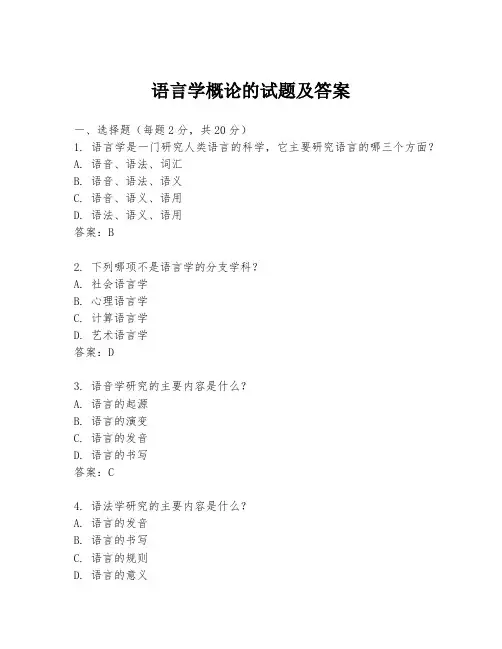
语言学概论的试题及答案一、选择题(每题2分,共20分)1. 语言学是一门研究人类语言的科学,它主要研究语言的哪三个方面?A. 语音、语法、词汇B. 语音、语法、语义C. 语音、语义、语用D. 语法、语义、语用答案:B2. 下列哪项不是语言学的分支学科?A. 社会语言学B. 心理语言学C. 计算语言学D. 艺术语言学答案:D3. 语音学研究的主要内容是什么?A. 语言的起源B. 语言的演变C. 语言的发音D. 语言的书写答案:C4. 语法学研究的主要内容是什么?A. 语言的发音B. 语言的书写C. 语言的规则D. 语言的意义答案:C5. 语义学研究的主要内容是什么?A. 语言的发音B. 语言的书写C. 语言的意义D. 语言的规则答案:C6. 语用学研究的主要内容是什么?A. 语言的发音B. 语言的书写C. 语言的使用D. 语言的意义答案:C7. 以下哪种语言现象不是词汇学研究的内容?A. 词义变化B. 词形变化C. 词序变化D. 词类变化答案:C8. 语言学研究的主要方法是什么?A. 观察法B. 实验法C. 比较法D. 所有以上答案:D9. 下列哪项不是语言学研究的对象?A. 语言的结构B. 语言的功能C. 语言的起源D. 语言的书写答案:D10. 语言学的研究可以应用于哪些领域?A. 教育B. 翻译C. 计算机科学D. 所有以上答案:D二、填空题(每题2分,共20分)1. 语言学的三个基本要素是______、______和______。
答案:语音、语法、语义2. 语言学的研究方法包括______、______和______。
答案:观察法、实验法、比较法3. 语言学的分支学科包括______、______和______。
答案:社会语言学、心理语言学、计算语言学4. 语音学研究的是______。
答案:语言的发音5. 语法学研究的是______。
答案:语言的规则6. 语义学研究的是______。
答案:语言的意义7. 语用学研究的是______。
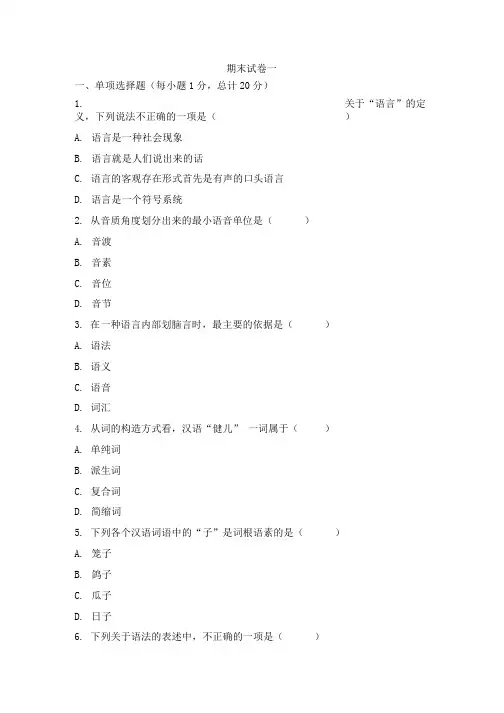
期末试卷一一、单项选择题(每小题1分,总计20分)1.关于“语言”的定义,下列说法不正确的一项是()A.语言是一种社会现象B.语言就是人们说出来的话C.语言的客观存在形式首先是有声的口头语言D.语言是一个符号系统2.从音质角度划分出来的最小语音单位是()A.音渡B.音素C.音位D.音节3.在一种语言内部划脑言时,最主要的依据是()A.语法B.语义C.语音D.词汇4.从词的构造方式看,汉语“健儿” 一词属于()A.单纯词B.派生词C.复合词D.简缩词5.下列各个汉语词语中的“子”是词根语素的是()A.笼子B.鸽子C.瓜子D.日子6.下列关于语法的表述中,不正确的一项是()A.语法是关于词的构成变化和词构成词组和句子的规则B.语法是说本族语的人的直觉知识和约定习惯C.语法是与语音、语汇等要素互不相关的规则D.语法是与语音、语汇等相比变化较慢的现象7.下列关于词义模糊性的表述中,正确的一项是()A.词义所指范围边缘区域模糊,中心区域明确B.词义所指范围边缘区域明确,中心区域模糊C.词义所指范围边缘区域、中心区域都模糊D.词义所指范围边缘区域可能模糊8.“哈巴狗”和“狮子狗”指的是同一种狗,二者在词义上的主要差别是()A.理性意义不同B.语体色彩不同C.形象色彩不同D.语气意义不同9.下列各项中,含有降级述谓结构的是()A.他申请去北京进修B.你去请他比较好C.他取下了挂在墙上的地图D.他害怕老师批评他10.下列各项中,甲和乙之间是预设关系的是()A.(甲)他有一件西服(乙)他有一件衣服B.(甲)他的西服破了(乙)他有一件西服C.(甲)那个学生借给他一本《红楼梦》一一(乙)那个人借给他一本《红楼梦》D.(甲)那个学生借给他一本《红楼梦》一一(乙)那个学生借给他一本书11.1956年我国推行汉字简化方案,将繁体字改成简体字,这属于()A.正字法改革B.字符类型改革C.文字类型改革D.字符类型和文字类型改革12.汉语中的“基因”来自英语的gene,从该词产生的方式看,“基因”属于(A.纯粹音译词B.音译兼意译词C.意译词D.仿译词13.从语言的发展演变来看,语汇系统中最不易发生变化的是()A.通用语汇B.常用语汇C.基本语汇D.专用语汇14.关于社会方言的形成,下列说法不正确的一项是()A.社会方言大多是在语言的相互接触中形成的B.社会方言是随着社会的社群分化而产生的C.一种语言的内部有可能形成社会方言D.一种方言的内部有可能形成社会方言15.关于共同语的形成,下列说法不正确的一项是()A.并不意味着方言分歧已经消失B.并不意味着方言分歧将会扩大C.并不意味着方言最终将被取代D.并不意味着语言已经实现统一16.关于语言规范化的推行,下列说法不正确的一项是()A.主要由权威机构提出具体的规范意见B.主要由权威机构强制推行C.主要通过教育机构、大众传媒等渠道向社会推行D.主要是一个积极引导社会公众自觉遵守的过程17.关于语言获得的原因,下列学说中偏重于内部条件解释的是()A.模仿说B.天赋说C.强化说D.刺激反应说18.社会语言学属于()A.理论语言学B.广义应用语言学C.普通语言学D.狭义应用语言学19.汉语中的:“了、着、过”在古代具有实实在在的词汇意义,到现代变成只表语义的助词,这属于()A.异化B.类化C.新语法范畴的形成D.实词虚化20.下列语言中属于粘着语的是()A.苗语B.越南语C.俄语D.日语二、多项选择(每个小题3分,共30分)1.根据舌位的高低,元音可分为()A.高兀音B.央元音C.半高元音D.半低元音E.低元音2.下列汉字的读音中多包含有辅音[飞]的有()A.男B.拉C.拿D.拦E.驴3.下列词中带有前缀的是(%1老鼠%1画家%1阿姨%1超越%1超现实主义4.下列词组叫,带双宾语的是()%1托你一件事%1托你办件事%1请你办这件事%1借你五元钱%1给你一本书5.下列语素中,属于枯着语素的是()%1宏%1伟%1大%1楼%1机6.卞列语言单位中,属于派生词的是()%1律师%1鸟儿%1老婆%1苦头%1文学家7.下列词中,处于同一个语义场的词是()%1桌子%1椅子%1沙发%1柜子%1鞋子8.下列语言属于印欧语系的是()%1法语%1英语%1德语%1阿拉伯语%1维吾尔语9.汉语属于()%1汉藏语系%1汉语族%1屈折语%1孤立语%1粘着语10.下列文字中属于表意文字的是()%1汉字%1中美洲的马雅文字%1古埃及的圣书字%1我国纳西族的东巴文%1古印度的法卢文三、判断题(每题2分,共20分)1.符号有视觉符号、听觉和触觉符号三种,语言是一种视觉符号。
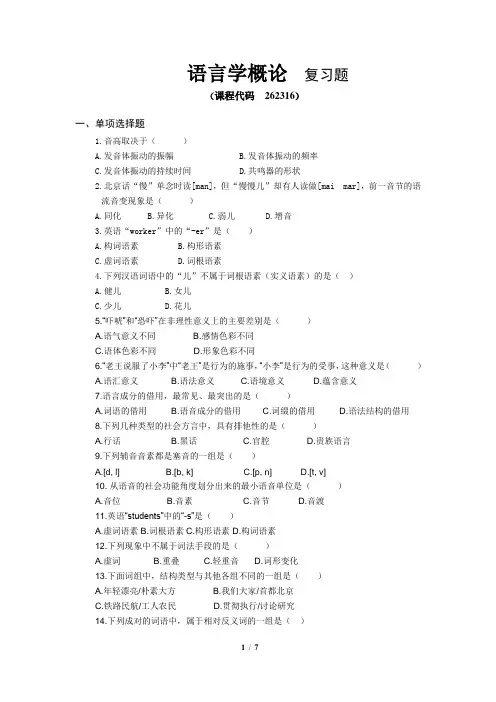
语言学概论复习题(课程代码262316)一、单项选择题1.音高取决于()A.发音体振动的振幅B.发音体振动的频率C.发音体振动的持续时间D.共鸣器的形状2.北京话“慢”单念时读[man],但“慢慢儿”却有人读做[mai mar],前一音节的语流音变现象是()A.同化B.异化C.弱儿D.增音3.英语“worker”中的“-er”是()A.构词语素B.构形语素C.虚词语素D.词根语素4.下列汉语词语中的“儿”不属于词根语素(实义语素)的是()A.健儿B.女儿C.少儿D.花儿5.“吓唬”和“恐吓”在非理性意义上的主要差别是()A.语气意义不同B.感情色彩不同C.语体色彩不同D.形象色彩不同6.“老王说服了小李”中“老王”是行为的施事,“小李”是行为的受事,这种意义是()A.语汇意义B.语法意义C.语境意义D.蕴含意义7.语言成分的借用,最常见、最突出的是()A.词语的借用B.语音成分的借用C.词缀的借用D.语法结构的借用8.下列几种类型的社会方言中,具有排他性的是()A.行话B.黑话C.官腔D.贵族语言9.下列辅音音素都是塞音的一组是()A.[d, l]B.[b, k]C.[p, n]D.[t, v]10. 从语音的社会功能角度划分出来的最小语音单位是()A.音位B.音素C.音节D.音渡11.英语“students”中的“-s”是()A.虚词语素B.词根语素C.构形语素D.构词语素12.下列现象中不属于词法手段的是()A.虚词B.重叠C.轻重音D.词形变化13.下面词组中,结构类型与其他各组不同的一组是()A.年轻漂亮/朴素大方B.我们大家/首都北京C.铁路民航/工人农民D.贯彻执行/讨论研究14.下列成对的词语中,属于相对反义词的一组是()A.成功—失败B.合法—非法C.本地—外地D.勤劳—懒惰15.造成“北京人多”一句歧义的主要原因是()A.一词多义B.不同的句法结构关系C.不同的语义结构关系D.不同的层次构造16.下列关于语言起源的表述中,正确的一项是()A.语言产生于人类对外界各种声音的摹仿B.语言产生于人们的相互约定C.语言是人类有意识地在短时间内创造出来的D.语言是人类在长期进化发展过程中创造出来的17.在儿童学会说话的过程中,“双词阶段”标志着儿童产生的语言能力是()A.语音能力B.语汇能力C.语法能力D.语义能力18.下列关于区别特征的表述中,不正确的一项是()A.音位是通过区别特征相互区别的B.区别特征完全取决于语音的自然属性C.音位的辨义功能由区别特征负担D.区别特征通常都表现为二项对立19.北京话“面”单念时读作[miæn],但“面包”却读作[miæmpu],这种语流音变现象是()A.弱化B.增音C.同化D.异化20.下列各组中,三个复合词构词类型不一致的一组是()A.席卷耳鸣地震B.打倒切断推翻C.发光散热出气D.天地欢乐爱好21.下列各组词,吸收外来成分的手段存在不一致的情况的一组是()A.丹麦挪威法兰西 B.沙拉咖啡麦当劳C.卡车啤酒立邦漆 D.香波克隆好莱坞22.下列关于“直接组成成分分析法”(层次分析法)的表述,不正确的一项是()A.从最大的词组开始逐层切分,一直切分到词为止B.从最小的词开始逐层组合,一直组合到词组为止C.分析时要依据两条原则:“成结构”和“有意义”D.分析时采用的方法是“先分主干”和“后添枝叶”23.“汽车”和“卡车”是()A.上下位词B.同义词C.等义词D.近义词24.判断两种话是不同语言还是同一种语言的不同方言应该主要参考()A.相互理解程度B.语言结构的差异程度C.共同的历史文化传统和民族认同感D.是否属于同一个国家单项选择题答案:1、B2、B3、A4、D5、C6、B7、A8、B9、B 10、A11、C 12、A 13、B 14、D 15、D 16、D 17、C 18、B 19、C 20、A21、D 22、D 23、A 24、C二、多项选择题1.从发音机制上看,一个舌面元音的特征取决于()A.舌位的高低B.舌位的前后C.嘴唇的圆展D.声带振动不振动E.送气不送气2.下列汉语复合词在构词方式上属于支配式的有()A.视力B.司机C.写作D.食物E.护膝3.从声音产生方面分析,音质的不同取决于()A.发音体不同B.发音体振动频率不同C.发音体振动幅度不同D.发音的方法不同E.共鸣器形状不同4.在汉语普通话中,下列各组三个合成词的结构类型完全一致的有()A.老虎老鼠老人B.瓜子女儿奔头C.第一初八阿姨D.记者画家教员E.房子花儿布头5、下列句子有歧义的是()A甲方在今年为乙方培养四个实验室工作人员。
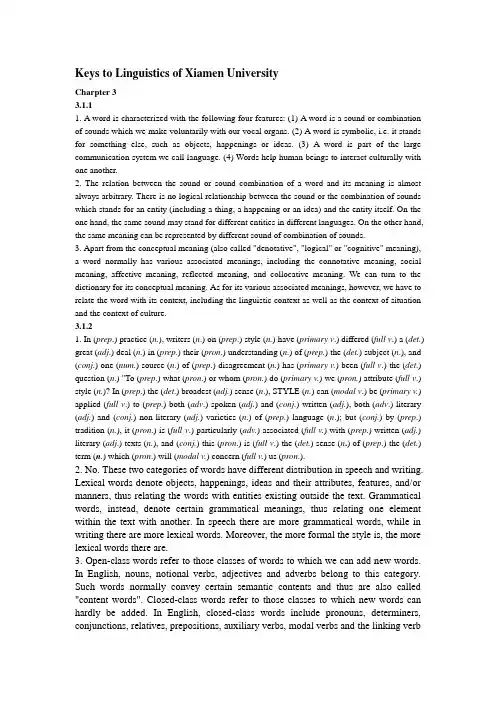
Keys to Linguistics of Xiamen UniversityCharpter 33.1.11. A word is characterized with the following four features: (1) A word is a sound or combination of sounds which we make voluntarily with our vocal organs. (2) A word is symbolic, i.e. it stands for something else, such as objects, happenings or ideas. (3) A word is part of the large communication system we call language. (4) Words help human beings to interact culturally with one another.2. The relation between the sound or sound combination of a word and its meaning is almost always arbitrary. There is no logical relationship between the sound or the combination of sounds which stands for an entity (including a thing, a happening or an idea) and the entity itself. On the one hand, the same sound may stand for different entities in different languages. On the other hand, the same meaning can be represented by different sound of combination of sounds.3. Apart from the conceptual meaning (also called "denotative", "logical" or "cognitive" meaning),a word normally has various associated meanings, including the connotative meaning, social meaning, affective meaning, reflected meaning, and collocative meaning. We can turn to the dictionary for its conceptual meaning. As for its various associated meanings, however, we have to relate the word with its context, including the linguistic context as well as the context of situation and the context of culture.3.1.21. In (prep.) practice (n.), writers (n.) on (prep.) style (n.) have (primary v.) differed (full v.) a (det.) great (adj.) deal (n.) in (prep.) their (pron.) understanding (n.) of (prep.) the (det.) subject (n.), and (conj.) one (num.) source (n.) of (prep.) disagreement (n.) has (primary v.) been (full v.) the (det.) question (n.) "To (prep.) what (pron.) or whom (pron.) do (primary v.) we (pron.) attribute (full v.) style (n.)? In (prep.) the (det.) broadest (adj.) sense (n.), STYLE (n.) can (modal v.) be (primary v.) applied (full v.) to (prep.) both (adv.) spoken (adj.) and (conj.) written (adj.), both (adv.) literary (adj.) and (conj.) non-literary (adj.) varieties (n.) of (prep.) language (n.); but (conj.) by (prep.) tradition (n.), it (pron.) is (full v.) particularly (adv.) associated (full v.) with (prep.) written (adj.) literary (adj.) texts (n.), and (conj.) this (pron.) is (full v.) the (det.) sense (n.) of (prep.) the (det.) term (n.) which (pron.) will (modal v.) concern (full v.) us (pron.).2. No. These two categories of words have different distribution in speech and writing. Lexical words denote objects, happenings, ideas and their attributes, features, and/or manners, thus relating the words with entities existing outside the text. Grammatical words, instead, denote certain grammatical meanings, thus relating one element within the text with another. In speech there are more grammatical words, while in writing there are more lexical words. Moreover, the more formal the style is, the more lexical words there are.3. Open-class words refer to those classes of words to which we can add new words. In English, nouns, notional verbs, adjectives and adverbs belong to this category. Such words normally convey certain semantic contents and thus are also called "content words". Closed-class words refer to those classes to which new words can hardly be added. In English, closed-class words include pronouns, determiners, conjunctions, relatives, prepositions, auxiliary verbs, modal verbs and the linking verb"to be". Their roles in the linguistic system are partly or wholly grammatical and thus are also called "grammatical words".3.2.11. 1) un- + bear + -able 2) watch + -ful 3) person+ -ify (i) + -cation4) un- + exception + -al + -ly 5) un- +educate +-(e)d 6) inspir(e) + -ing7) soft + heart + -ed 8) horse + man + -ship2. 1) 3: geo- + -graph + -y 2) 4: inter- +nation + -al + -ly 3) 2: forget + -(t)en4) 1: Washington 5) 2: inform + -ation 6) 4: industry (i) + -al +-iz(e) + -ation7) 3: pre- + dominat(e) + -ant 8) 2: pre- + conscious3. The plural s has 5 morphologically-conditioned allomorphs: (1) -(e)s, as in "cats", "matches"; (2) -(r)en: as in "oxen", "children"; (3) -e-: as in "men", "women"; (4) -ee-, as in "feet", "teeth"; and (5) zero, as in "sheep", "deer".3.2.21. 1) inspire: into 2) intransigent: not 3) insufficient: not 4) insert: into5) insoluble: not 6) intact: not 7) impenetrable: not 8) immutable: not9) illicit: not 10) irretrievable: not2. 1) prince - princess 2) emperor - empress 3) waiter - waitress 4) Paul –Paula 5) fiancé - fiancée 6) hero - heroine 7) king - queen8) ox - cow9) wolf - she-wolf 10) doctor- woman doctor3. 1) operation - operations 2) responsibility - responsibilities3) proposal - proposals 4) modernize - modernization5) beautify - beautifies 6) activate - activates7) funny - funnier 8) friendly - friendlier3.3.11. Inflection refers to the process of adding an affix to a word or changing it in some other way according to the grammatical rules of the language. English inflections are used to express certain grammatical meanings: the plural morpheme {s} to change the noun into the plural-number form, the generative-case morpheme {'s} to indicate the relation of possession, the feminine-gender morpheme {ess} to change the masculine noun into its corresponding feminine-gender form, the third-person singular {s} to change the verb into the third-person singular form, the -ing participle {ing} to change the verb into the -ing participle, the past-form morpheme {ed} to change the verb into the past-tense form, the past-participle morpheme {ed} to change the verb into the -ing participle, the comparative {er} to change an adjective into the comparative-degree form, and the superlative {est} to change an adjective into the superlative-degree form.2. No, inflection is not universal. Different languages have different morphology. There are languages, like Latin and Sanskrit, which abound in inflectional morphemes. There are also languages, like Chinese, which have no inflectional morphemes. Between these two extremes are some intermediate languages, like English, which have comparatively few inflectional morphemes than languages of the first category.3. Omitted.3.3.21. 1) password: word to be passed 2) housewife: wife in charge of a household3) sunshine: shine of the sun 4) milkman: man who sells or delivers milk5) sunflower: plant whose flower faces the sun6) apple pie: pie consisting of a filling of apples7) mosquito net: net to prevent mosquitoes 8) daydream: dream in the daytime9) freezing-point: point at which a liquid freezes 10) flashlight: light of a flash2. Abbreviation refers to the way in which a longer word or expression is abbreviated or shortened. In both English and Chinese, longer words can be abbreviated via clipping, blending, and initials and acronyms. However, differences exist. While English words are made up of letters which can be pronounced into syllables, Chinese words are made up of characters each of which is normally pronounced as a separate syllable. While the English language differentiates blending, initials and acronyms, the Chinese language makes no such differentiation. In Chinese, the major approach to abbreviating a longer expression is usually to combine the first character of each of the constituent words into a shortened expression, in which the constituent characters are pronounced individually. Another commonly-used way of abbreviation in Chinese is to combine a numeral and the head word of a series of parallel constructions, as in "四化".3. The English language normally adds new words to its vocabulary through coinage, compounding, derivation, abbreviation, imitation, and borrowing.3.4.11. 1) 11:他/在/学校/表现/很/好/,是/个/优秀/学生/干部/。
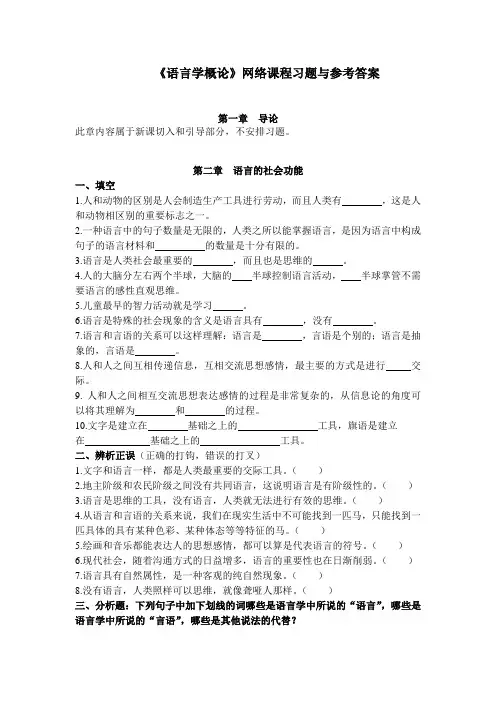
《语言学概论》网络课程习题与参考答案第一章导论此章内容属于新课切入和引导部分,不安排习题。
第二章语言的社会功能一、填空1.人和动物的区别是人会制造生产工具进行劳动,而且人类有,这是人和动物相区别的重要标志之一。
2.一种语言中的句子数量是无限的,人类之所以能掌握语言,是因为语言中构成句子的语言材料和的数量是十分有限的。
3.语言是人类社会最重要的,而且也是思维的。
4.人的大脑分左右两个半球,大脑的半球控制语言活动,半球掌管不需要语言的感性直观思维。
5.儿童最早的智力活动就是学习。
6.语言是特殊的社会现象的含义是语言具有,没有。
7.语言和言语的关系可以这样理解:语言是,言语是个别的;语言是抽象的,言语是。
8.人和人之间互相传递信息,互相交流思想感情,最主要的方式是进行交际。
9.人和人之间相互交流思想表达感情的过程是非常复杂的,从信息论的角度可以将其理解为和的过程。
10.文字是建立在基础之上的工具,旗语是建立在基础之上的工具。
二、辨析正误(正确的打钩,错误的打叉)1.文字和语言一样,都是人类最重要的交际工具。
()2.地主阶级和农民阶级之间没有共同语言,这说明语言是有阶级性的。
()3.语言是思维的工具,没有语言,人类就无法进行有效的思维。
()4.从语言和言语的关系来说,我们在现实生活中不可能找到一匹马,只能找到一匹具体的具有某种色彩、某种体态等等特征的马。
()5.绘画和音乐都能表达人的思想感情,都可以算是代表语言的符号。
()6.现代社会,随着沟通方式的日益增多,语言的重要性也在日渐削弱。
()7.语言具有自然属性,是一种客观的纯自然现象。
()8.没有语言,人类照样可以思维,就像聋哑人那样。
()三、分析题:下列句子中加下划线的词哪些是语言学中所说的“语言”,哪些是语言学中所说的“言语”,哪些是其他说法的代替?1.杨朔散文的语言真美!2.你这个人真不会说话。
3.他会说好几国的话。
4.两个人熟了,自然也就有了共同语言。
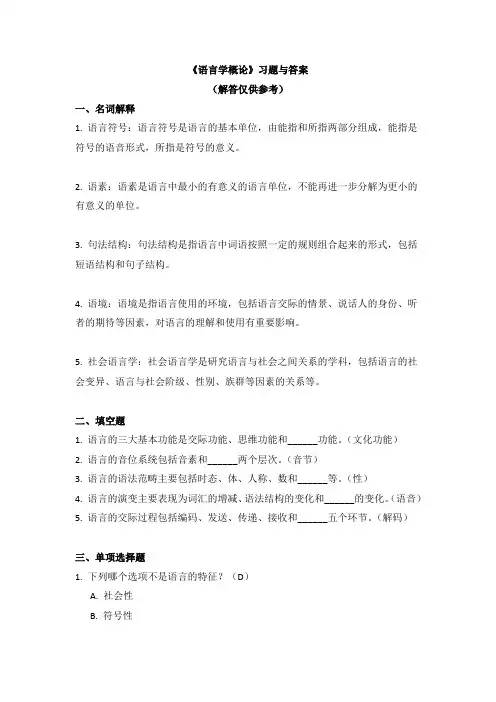
《语言学概论》习题与答案(解答仅供参考)一、名词解释1. 语言符号:语言符号是语言的基本单位,由能指和所指两部分组成,能指是符号的语音形式,所指是符号的意义。
2. 语素:语素是语言中最小的有意义的语言单位,不能再进一步分解为更小的有意义的单位。
3. 句法结构:句法结构是指语言中词语按照一定的规则组合起来的形式,包括短语结构和句子结构。
4. 语境:语境是指语言使用的环境,包括语言交际的情景、说话人的身份、听者的期待等因素,对语言的理解和使用有重要影响。
5. 社会语言学:社会语言学是研究语言与社会之间关系的学科,包括语言的社会变异、语言与社会阶级、性别、族群等因素的关系等。
二、填空题1. 语言的三大基本功能是交际功能、思维功能和______功能。
(文化功能)2. 语言的音位系统包括音素和______两个层次。
(音节)3. 语言的语法范畴主要包括时态、体、人称、数和______等。
(性)4. 语言的演变主要表现为词汇的增减、语法结构的变化和______的变化。
(语音)5. 语言的交际过程包括编码、发送、传递、接收和______五个环节。
(解码)三、单项选择题1. 下列哪个选项不是语言的特征?(D)A. 社会性B. 符号性D. 固定性2. 下列哪个选项不属于语言的音位特征?(C)A. 对立性B. 相关性C. 模仿性D. 系统性3. 下列哪个选项不是语言的变体?(B)A. 地域方言B. 书面语C. 社会方言D. 个人语言4. 下列哪个选项不属于语言的内部结构?(D)A. 词汇B. 语法C. 语义D. 语用5. 下列哪个选项不是语言接触的结果?(A)A. 语言分化B. 语言融合C. 语言借用D. 语言干扰四、多项选择题1. 下列哪些选项是语言的音位特征?(ABCD)B. 相关性C. 系统性D. 情景性2. 下列哪些选项是语言的社会功能?(ABCD)A. 交际功能B. 思维功能C. 文化功能D. 认知功能3. 下列哪些选项是语言的变异现象?(ABCD)A. 语音变异B. 词汇变异C. 语法变异D. 语用变异4. 下列哪些选项是语言的类型学分类依据?(ABC)A. 词序B. 虚词C. 形态D. 语调5. 下列哪些选项是语言的交际原则?(ABCD)A. 合作原则B. 礼貌原则C. 关联原则D. 方式原则五、判断题1. 语言是一种自然现象。
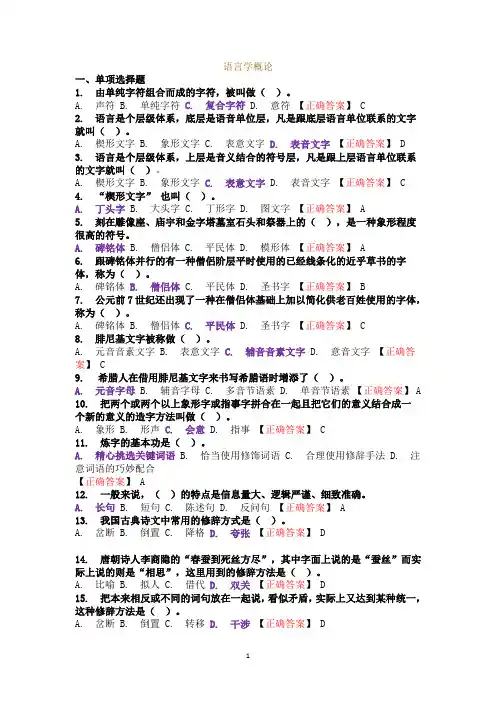
语言学概论一、单项选择题1. 由单纯字符组合而成的字符,被叫做()。
A. 声符B. 单纯字符C. 复合字符D. 意符【正确答案】 C2. 语言是个层级体系,底层是语音单位层,凡是跟底层语言单位联系的文字就叫()。
A. 楔形文字B. 象形文字C. 表意文字D. 表音文字【正确答案】 D3. 语言是个层级体系,上层是音义结合的符号层,凡是跟上层语言单位联系的文字就叫()。
A. 楔形文字B. 象形文字C. 表意文字D. 表音文字【正确答案】 C4. “楔形文字” 也叫()。
A. 丁头字B. 大头字C. 丁形字D. 图文字【正确答案】 A5. 刻在雕像座、庙宇和金字塔墓室石头和祭器上的(),是一种象形程度很高的符号。
A. 碑铭体B. 僧侣体C. 平民体D. 模形体【正确答案】 A6. 跟碑铭体并行的有一种僧侶阶层平时使用的已经线条化的近乎草书的字体,称为()。
A. 碑铭体B. 僧侣体C. 平民体D. 圣书字【正确答案】 B7. 公元前7世纪还出现了一种在僧侣体基础上加以简化供老百姓使用的字体,称为()。
A. 碑铭体B. 僧侣体C. 平民体D. 圣书字【正确答案】 C8. 腓尼基文字被称做()。
A. 元音音素文字B. 表意文字C. 辅音音素文字D. 意音文字【正确答案】 C9.希腊人在借用腓尼基文字来书写希腊语时增添了()。
A. 元音字母B. 辅音字母C. 多音节语素D. 单音节语素【正确答案】 A10. 把两个或两个以上象形字或指事字拼合在一起且把它们的意义结合成一个新的意义的造字方法叫做()。
A. 象形B. 形声C. 会意D. 指事【正确答案】 C11. 炼字的基本功是()。
A. 精心挑选关键词语B. 恰当使用修饰词语C. 合理使用修辞手法D. 注意词语的巧妙配合【正确答案】 A12. 一般来说,()的特点是信息量大、逻辑严谨、细致准确。
A. 长句B. 短句C. 陈述句D. 反问句【正确答案】 A13. 我国古典诗文中常用的修辞方式是()。
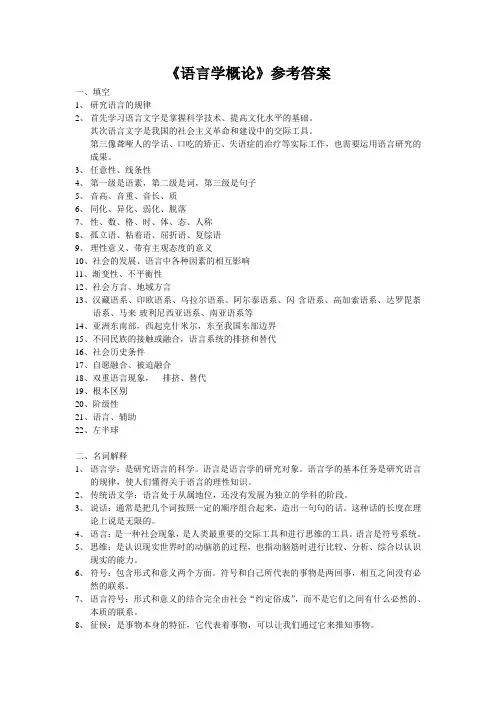
《语言学概论》参考答案一、填空1、研究语言的规律2、首先学习语言文字是掌握科学技术、提高文化水平的基础。
其次语言文字是我国的社会主义革命和建设中的交际工具。
第三像聋哑人的学话、口吃的矫正、失语症的治疗等实际工作,也需要运用语言研究的成果。
3、任意性、线条性4、第一级是语素,第二级是词,第三级是句子5、音高、音重、音长、质6、同化、异化、弱化、脱落7、性、数、格、时、体、态、人称8、孤立语、粘着语、屈折语、复综语9、理性意义、带有主观态度的意义10、社会的发展、语言中各种因素的相互影响11、渐变性、不平衡性12、社会方言、地域方言13、汉藏语系、印欧语系、乌拉尔语系、阿尔泰语系、闪-含语系、高加索语系、达罗毘荼语系、马来-玻利尼西亚语系、南亚语系等14、亚洲东南部,西起克什米尔,东至我国东部边界15、不同民族的接触或融合,语言系统的排挤和替代16、社会历史条件17、自愿融合、被迫融合18、双重语言现象,排挤、替代19、根本区别20、阶级性21、语言、辅助22、左半球二、名词解释1、语言学:是研究语言的科学。
语言是语言学的研究对象。
语言学的基本任务是研究语言的规律,使人们懂得关于语言的理性知识。
2、传统语文学:语言处于从属地位,还没有发展为独立的学科的阶段。
3、说话:通常是把几个词按照一定的顺序组合起来,造出一句句的话。
这种话的长度在理论上说是无限的。
4、语言:是一种社会现象,是人类最重要的交际工具和进行思维的工具。
语言是符号系统。
5、思维:是认识现实世界时的动脑筋的过程,也指动脑筋时进行比较、分析、综合以认识现实的能力。
6、符号:包含形式和意义两个方面。
符号和自己所代表的事物是两回事,相互之间没有必然的联系。
7、语言符号:形式和意义的结合完全由社会“约定俗成”,而不是它们之间有什么必然的、本质的联系。
8、征候:是事物本身的特征,它代表着事物,可以让我们通过它来推知事物。
9、组合关系:符号和符号组合起来的关系。
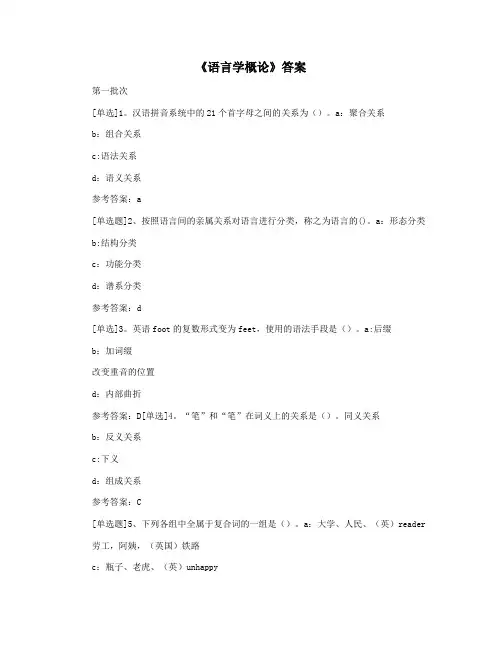
《语言学概论》答案第一批次[单选]1。
汉语拼音系统中的21个首字母之间的关系为()。
a:聚合关系b:组合关系c:语法关系d:语义关系参考答案:a[单选题]2、按照语言间的亲属关系对语言进行分类,称之为语言的()。
a:形态分类 b:结构分类c:功能分类d:谱系分类参考答案:d[单选]3。
英语foot的复数形式变为feet,使用的语法手段是()。
a:后缀b:加词缀改变重音的位置d:内部曲折参考答案:D[单选]4。
“笔”和“笔”在词义上的关系是()。
同义关系b:反义关系c:下义d:组成关系参考答案:C[单选题]5、下列各组中全属于复合词的一组是()。
a:大学、人民、(英)reader 劳工,阿姨,(英国)铁路c:瓶子、老虎、(英)unhappyd:道路、材料、(英语)教室参考答案:d[多项选择]6。
“紧张”和“放松”在汉语中的意思()答:这是相反的关系b:是重叠关系c:有时相反,有时重叠d:既有反义又有同义的因素e:没有同义因素参考答案:ad[多项选择]7。
元音的音质取决于(a):开口的大小b:发音体整动的频率c:前后舌位d:嘴唇的圆展e:发音位置和发音方法参考答案:acd[选择题]8。
以下说法是错误的:(a)语音进化规律只在一定时期内有效b:语法发展中的类推作用是无限的,可推而广之,无一例外。
古汉语中的浊音在现代汉语中已经消失了d:随着旧事物的消失,表示它们的词语也会随之消失e:单词的替换都取决于语言系统的内部原因参考答案:bce[true或false]9[a],[a],?]它们是普通话中同一音素的三个自由变体。
参考答案:错误【判断问题】10。
汉字对应于汉语音节。
一个单词只记录一个音节,一个音节只记录一个汉字。
参考答案:错误第二批次[单选]1。
中文是“北平”→ “北京”和“德律风”→ “电话”,单词替换的原因是社会因素b:语言系统内部的因素c:前者是语言系统的内部因素,后者是社会因素d:前者是社会因素,后者是语言系统内部因素参考答案:D[单选]2。
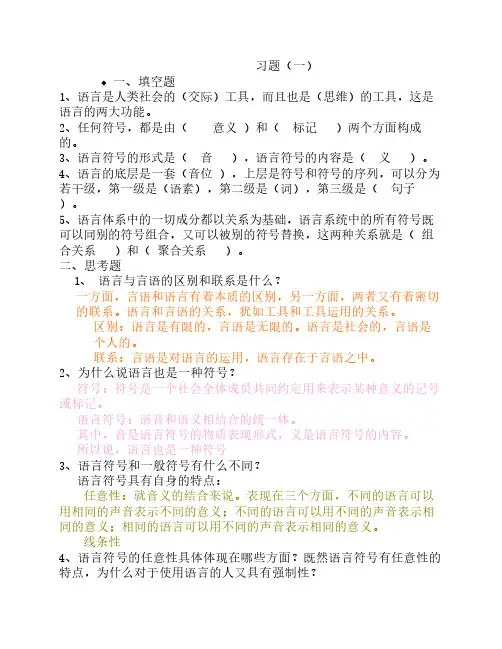
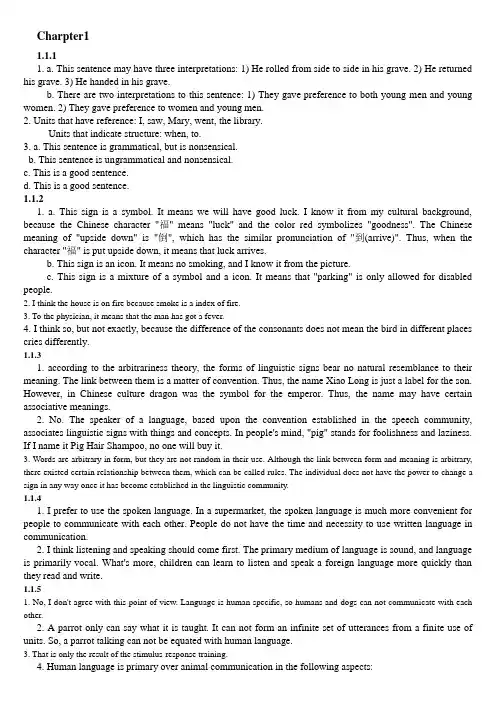
Charpter11.1.11. a. This sentence may have three interpretations: 1) He rolled from side to side in his grave. 2) He returned his grave. 3) He handed in his grave.b. There are two interpretations to this sentence: 1) They gave preference to both young men and young women. 2) They gave preference to women and young men.2. Units that have reference: I, saw, Mary, went, the library.Units that indicate structure: when, to.3. a. This sentence is grammatical, but is nonsensical.b. This sentence is ungrammatical and nonsensical.c. This is a good sentence.d. This is a good sentence.1.1.21. a. This sign is a symbol. It means we will have good luck. I know it from my cultural background, because the Chinese character "福" means "luck" and the color red symbolizes "goodness". The Chinese meaning of "upside down" is "倒", which has the similar pronunciation of "到(arrive)". Thus, when the character "福" is put upside down, it means that luck arrives.b. This sign is an icon. It means no smoking, and I know it from the picture.c. This sign is a mixture of a symbol and a icon. It means that "parking" is only allowed for disabled people.2. I think the house is on fire because smoke is a index of fire.3. To the physician, it means that the man has got a fever.4. I think so, but not exactly, because the difference of the consonants does not mean the bird in different places cries differently.1.1.31. according to the arbitrariness theory, the forms of linguistic signs bear no natural resemblance to their meaning. The link between them is a matter of convention. Thus, the name Xiao Long is just a label for the son. However, in Chinese culture dragon was the symbol for the emperor. Thus, the name may have certain associative meanings.2. No. The speaker of a language, based upon the convention established in the speech community, associates linguistic signs with things and concepts. In people's mind, "pig" stands for foolishness and laziness. If I name it Pig Hair Shampoo, no one will buy it.3. Words are arbitrary in form, but they are not random in their use. Although the link between form and meaning is arbitrary, there existed certain relationship between them, which can be called rules. The individual does not have the power to change a sign in any way once it has become established in the linguistic community.1.1.41. I prefer to use the spoken language. In a supermarket, the spoken language is much more convenient for people to communicate with each other. People do not have the time and necessity to use written language in communication.2. I think listening and speaking should come first. The primary medium of language is sound, and language is primarily vocal. What's more, children can learn to listen and speak a foreign language more quickly than they read and write.1.1.51. No, I don't agree with this point of view. Language is human specific, so humans and dogs can not communicate with each other.2. A parrot only can say what it is taught. It can not form an infinite set of utterances from a finite use of units. So, a parrot talking can not be equated with human language.3. That is only the result of the stimulus-response training.4. Human language is primary over animal communication in the following aspects:1) Human has the ability to refer to things far remote in time and space. In contrast, it may be impossible for an animal to convey such ability.2) Human has the ability to produce and understand an indefinite number of novel utterances, but no animal can communicate creatively with another animal.3) Learning is much more important as a factor in human language than in animal communication.4) Human language structure and language use are vastly more complex than any animal communication system.5) Animal communication systems are closed-ended, whereas human languages are open-ended.1.1.61. The advanced technology such as telephones and the Internet makes human communication become much more convenient and frequent. People can communicate with others in remote places freely.2. There may exist several causes:1) The sender can not express himself or herself clearly.2) The receiver can not understand what the sender said.3) The receiver is unwilling to communicate with the sender.4) There exists misunderstanding because of the different cultural background of the sender and the receiver.3. We must pay key attention to learning the knowledge of the ways of thinking, acting and speaking of a language, for differences in this kind of knowledge may cause trouble in intercultural communication.1.2.11. a. Physiological functionb. Performative functionc. Phatic functiond. Informative function2. People like poetry because people can enjoy the rhythm and the melody of certain combinations of sounds in the poetry. And most creative uses of language in the poetry can provide people considerable pleasure through the generation of puns, paradoxes, ambiguities and metaphors.3. I may not say anything, but move the desk away.1.2.21. General functions refer to the particular individual uses of language whilst metafunctions refer to the larger, more general purposes underlying language use.2. No. According to Halliday, every sentence in a text is multifunctional and has three metafunctions simultaneously: ideational, interpersonal and textual functions.3. Halliday's functional theory emphasizes the relationship between language structure and the language functions in social life, while the traditional grammar emphasizes the forms of the sentence.1.3.11. I agree to the evolutionary theory which tends to believe that man evolved from lower forms of life, and so did language. This is a scientific approach to the origin of language as it is based on a wide range of studies over years by biologists, anthropologists, psychologists, neurologists, primatologists and linguists. With many significant changes since its early introduction, the evolutionary theory shows us the origin of language from various aspects, such as the organic evolution, environmental factors.2. 轰隆、乒乓、叽叽嘎嘎、叽里咕噜、汪汪3. Onomatopoetic words are imitations of the sounds of nature, and emotional ejaculations of pain, fear, surprise, pleasure, anger, etc. According to the invention theory, onomatopoetic words form the basis of language, or at least the core of the basic vocabulary.1.3.21. Usually, there are two main ways of classifying languages: the genetic (or genealogical) and the typological. The historical classification is based on the assumption that languages have diverged from a common ancestor. This criteria is to research into the history and relatedness of languages. On the other hand, the typological classification is based on a comparison of the formal similarities which exist between languages.。
《语言学概论》习题答案选择题第一章总论□ 言语是×. 言论与语言×. 音义结合的符号系统√. 说话和所说的话□ 语言是一种×. 形式和内容相统一的视觉符号√. 音义结合的听觉符号系统×. 用来交际的触觉符号系统□ 抽象思维的一般特性是×. 概括性、民族性×. 概念、判断、推理×. 固定、再现、改造√. 概括性、社会性□ 语言是思维的工具指的是×. 一切思维必须由语言完成√. 主要指抽象思维和直观动作思维、形象思维的高级阶段离不开语言×. 指直观动作思维和表象思维离不开语言□思维的三种类型是√. 直观动作思维、表象思维、抽象思维×. 概念、判断、推理×. 固定、再现、改造□ 语言符号的任意性是×. 语言符号的创造和使用总是任意的2×. 我们可以任意理解语言的符号√. 语言符号音义之间没有本质的联系□ 语言符号的线条性×. 语言符号的排列没有阶级性,象一根线条排列在一起×. 语言符号一个跟一个依次出现,随时间推移不分层次逐渐延伸√. 语言符号在时间的线条上逐个出现,同时不排除层次性□ "他肯定不会来了!" 这句话强调了说者的×. 说话行为√. 施事行为×. 取效行为×. 言语行为□ 汉语声调从中古到现代的"平分阴阳,入派三声"的规律是√. 个别语言的发展规律×. 一般语言的发展规律×. 汉民族各种方言的发展规律□ 一个民族内部共同使用的语言称为√. 民族共同语×. 民族交际语×. 国际交际语□ 克里奥尔语是语言的√. 混合×. 融合×. 分化×. 整化□ 语言融合的"底层"现象是×. 语言装置的最下面一层,即语音部分√. 被融合的语言的某些遗留下来的因素×. 被压迫的阶层第二章语音□ 声调决定于√. 音高×. 音强×. 音长×. 音质□ [p、t?、b、k]在发音方法上的共同特点是×. 清音×. 不送气√. 塞音×. 擦音□ 舌尖后浊擦音是×. [x] ×. [b]√. [?] ×. [z]□ [tA](大)是√. 开音节×. 闭音节×. 元音首音节√. 辅音首音节□ [](血)中的[?]是×. 起音√. 领音×. 收音□ [kai51](盖)中的[i]是×. 起音×. 领音√. 收音×. 辅音□ 普通话[?in55k?u214](辛苦)快读是[?i? 55k?u214]这种现象是×. 顺同化√. 逆同化×. 顺异化×. 逆异化×. 弱化×. 脱落□ 普通话[f?n214pi214]快读是[f?m35pi214]这种现象是×. 顺同化√. 逆同化×. 顺异化√. 逆异化课后答案网阳光大学生网4×. 弱化×. 脱落□ 普通话[tou51fu214](豆腐)快读是[tou51f]这种现象是×. 同化×. 异化×. 弱化√. 脱落×. 增音第三章语义□ ________是指语言单位的意义在一定的语境的作用下,内部变得具体、丰富或增加一些附加意义。
语言学概论课后题答案导言二、填空1、中国、印度、希腊—罗马。
2、文字、音韵、训诂。
3、语音、词汇、语义—语法。
4、编码、发送、传递、接收。
5、横的方面、纵的方面、共时、历时。
6、历史比较。
7、《语言论》8、索绪尔三、问答题1、指导2页2、教材3页3、指导3—4页4、教材4—5页5、指导4—5页6、指导3页第一章一、解释下列名词1、语言(自己总结)2、说话(教材9页)3、交际工具:人类交流思想的手段、方式。
4、社会现象(指导14页)5、思维(教材13页)二、填空1、语言2、规则3、交际工具、工具4、同意、不同意、再见、鼓掌、痛恨、高兴5、左、直观思维6、sister uncle7、量词8、语言9、全民性、阶级性10、社会的、具体三、判断正误1、对2、错3、错4、错5、对6、错7、错8、错9、对10、对11、对12、错13、对14、对15、错16、错17、对18、对19、错20、对四、问答题1、自己总结2、教材9页3、教材9页4、教材36页5、自己做6、语言没有阶级性7、教材11页8、教材11页9、谁的观点也不正确,因为语言与思维的关系是相辅相成的10、教材10页第二章一、名称解释1、符号(指导23页)2、符号的任意性(教材29页)3、二层性(教材31页)4、组合关系(教材33页)5、聚合关系(教材33页)二、填空1、形式、内容2、内容、形式3、声音、意义、物质表现形式4、约定俗成的5、任意性、线条性6、音位、序列、语素、词7、组合关系、聚合关系8、组合关系、聚合关系9、抽象思维、发音三、判断正误1、错2、对3、错4、错5、对6、对7、对8、对9、错10、对11、错12、错13、错14、对15、对16、对17、对18、错19、对20、错四、问答题1、指导23页2、教材31页3、教材26页4、教材27页5、教材29页6、教材29页7、教材29页8、教材31页9、教材31页10、教材33页第三章一、填空1、音素2、拉丁3、音高、音重、音长、音质、音高4、肺、喉头和声带、口腔鼻腔咽腔、共鸣腔5、元音、辅音、受阻6、舌位的高低、前后、圆展、央、低、不圆唇7、发音部位、发音方法、双唇、不送气、清、塞8、音位9、条件变体、自由变体、自由变体10、声母、韵母、声调、韵母、韵头、韵尾11、开口呼、合口呼、齐齿呼、撮口呼12、脱落二、单项选择题1、D2、D3、A4、A5、C6、D7、B8、B9、D 10、C三、判断正误1、错2、对3、错4、错5、错6、错7、对8、错9、对10、对四、名称解释1、音质(教材50页)2、元音(教材59页)3、送气(教材63页)4、音位变体(指导51页)5、区别特征(教材77页)五、分析题(用元音舌位图和辅音表自己做)六、问答题1、教材57—58页2、教材59页3、教材59页4、指导49—50页5、教材82页第四章一、举例解释下列名词1、语法是词的构成、变化和用词造句的规则。
《语言学概论》练习(一)参考答案一、填空1、中国、印度、希腊—罗马具有悠久的历史文化传统,是语言学的三大发源地。
2、历史比较语言学是在19世纪逐渐发展和完善的,它是语言学走上独立发展道路的标志。
3、人的大脑分左右两半球,大脑的左半球控制语言活动,右半球掌管不需要语言的感性直观思维。
4、一个符号,如果没有意义,就失去了存在的必要,如果没有形式,我们就无法感知,符号也就失去了存在的物质基础。
5、用什么样的语音形式代表什么样的意义,完全是由使用这种语言的社会成员约定俗成。
6、语言符号具有任意性和线条性特点。
7、语言的底层是一套音位,上层是符号和符号的序列,可以分为若干级,第一级是语素,第二级是词,第三级是句子。
8、语言系统中的所有符号,既可以同别的符号组合,又可以被别的符号替换,符号之间的这种关系是组合关系和聚合关系。
9、组合关系是指符号与符号相互之间在功能上的联系,聚合关系是指符号在性质上的归类。
二、判断正误1、文字是人类最重要的交际工具。
(错)2、地主阶级和农民阶级之间没有共同语言,这说明语言是有阶级性的。
(错)3、在现代社会,文字比语言更加重要。
(错)4、现代社会,沟通的方式很多,语言的重要性日渐削弱。
(错)5、语言是思维的工具,没有语言,人类就无法思维。
(对)6、语言和思维互相依存,共同发展。
(对)7、任何一种符号,都是由内容和意义两个方面构成的。
(错)8、从本质上看,语言其实是一种符号系统。
(对)9、人类选择语音而不是色彩、手势作为语言符号的形式,是因为语音比较好听。
(错)10、语言符号的约定俗成是指语音形式和意义内容的结合是社会成员共同约定认同的。
(对)三、问答题:1、语言的作用是什么,举例说明。
为什么说语言是最重要的交际工具?答:它是人类社会的交际工具。
每个社会,无论它是经济发达的社会,还是经济十分落后的社会,都必须有属于自己的语言,都离不开语言这个交际工具,语言是组成社会必不可少的一个因素,是人类与动物区别的重要特征之一。
《语言学概论》综合练习参考答案一、重要名词解释:(考试时名词解释一定要举例)1、语言学:《期末复习指导》第13页。
2、普通语言学:《学习指导书》第4页末段。
3、专语语言学:《学习指导书》第4页倒数第二段。
4、历史比较语言学:又称比较语法,它通过语言亲属关系的比较研究语言的发展规律,拟测它们的共同母语。
它是在19世纪逐步发展和完善的,主要是印欧语系的历史比较。
它为现代语言学的建立奠定了坚实的基础,并使语言学走上独立发展的道路。
5、语言:语言是语音和语义结合的符号系统,是人类社会最重要的交际工具,是一种特殊的社会现象,是人类思维的最有效的工具。
6、二层性:语言是由一定的单位按照一定的层级组成的,可分为音位层和符号层,其音位层和符号层我们合称为语言的二层性。
7、任意性:《期末复习指导》第17页末段。
8、符号:《期末复习指导》第17页第一段。
9、组合关系:组合关系就是两个同一性质的结构单位(如音位与音位、词与词等等)按照线性的顺序组合起来的关系。
简单地说,就是符号与符号相互组合起来的关系。
10、聚合关系:聚合关系就是语言结构某一位置上能够互相替换的具有某种相同作用的单位(如音位、词)之间的关系,简单说就是符号与符号之间的替换关系。
11、语音:《期末复习指导》第20页;12、音素(后有语素,估计是印刷错误):《期末复习指导》第21页;13、元音:《期末复习指导》第21页;14、辅音:《期末复习指导》第21页;15、音标:《期末复习指导》第21页;16、发音部位:《期末复习指导》第22页;17、发音方法:《期末复习指导》第22页;18、音位:《期末复习指导》第22页;19、音位变体:是a音位的变异形式,是a音位的变体。
20、区别特征:《期末复习指导》第24页倒数第二段;21、音节:《期末复习指导》第25页;22、语流音变:书第83页倒数第二段;23、语法:语法就是用词造句的规则系统,它是词的构成规则、变化规则、组合规则的总和。
课后习题思考题1.答:人们在各个领域的活动中都离不开语言,语言活动深入到人类生活的一切领域,这种情况必然使语言学和其他学科发生密切的联系,因此说,语言学在现代科学体系中处于领先和关键的重要地位。
⑴语言学的特定研究对象,即人类的语言几乎牵涉到现代科学的每个学科。
现代许多学科的发展最后都与语言问题、思维问题等有关,语言学的突破必将为这些学科的发展起到促进作用。
⑵语言学与社会科学、自然科学有着密切的联系,围绕着语言学,已经形成了众多的边缘学科。
2.答:语言的应用研究统称为应用语言学,它着重解决现实中与语言有关的各种实际问题,把语言学的基础研究成果转化为社会效益。
根据研究范围的不同,应用语言学有狭义和广义之分。
狭义应用语言学主要以语言教学问题为研究对象, 基本可以看作是语言教学的理论与方法的科学。
语言教学包括第一语言教学即本族语的教学和第二语言教学即外族语的教学。
第一语言的学习非常重要,因为它是学习各门知识的基础和手段,也是进行各种交际活动的工具。
第二语言教学包括本族人学习外族语及教外族人学习本族语。
广义应用语言学是把语言学的研究成果同有关学科的某些实用研究结合起来,着重解决有关学科及语言学本身所涉及的应用方面的问题。
它主要包括语言统计、信息传递、自动控制、情报检索、机器翻译、人机对话、人工智能、自然语言理解、语言文字信息处理等。
此外,还涉及到语言规划、语言的使用等问题。
3.答:转换生成语言学的创始人是美国语言学家诺姆-乔姆斯基。
转换生成语言学的研究对象是语言能力而不是语言行为。
1957年,乔姆斯基出版《句法结构》一书,标志着转换生成语言学的诞生。
转换生成语法理论是欧美语言学理论中最有影响的一种,因此,它的诞生被称为“乔姆斯基革命”。
乔姆斯基的生成语法学理论使我们在一定程度上摆脫了行为主义言语获得理论的束缚,认识到婴儿言语获得过程中神经系统的重要作用,同时也向我们提出了研究言语过程的心理机制的问题,这是很有理论意义和借鉴价值的。
语言学概论习题答案语言学概论习题答案语言学是研究语言的科学,它探讨语言的结构、语言的产生与发展、语言的使用等方面的问题。
在学习语言学的过程中,习题是一种常见的学习方式,通过解答习题可以加深对语言学知识的理解和应用。
下面将给出一些语言学概论习题的答案,希望对读者有所帮助。
1. 什么是语言?答:语言是人类特有的交流工具,是一种符号系统,通过声音、文字、手势等方式来传达信息和表达意思。
语言具有符号性、社会性、可创造性和可学习性等特点。
2. 语言的基本单位是什么?答:语言的基本单位是语音、词汇、句子和篇章。
语音是语言的最小单位,是由音素组成的;词汇是语言的基本词汇库,是由词汇项组成的;句子是语言的基本语法单位,由词汇按照一定的语法规则组成;篇章是由多个句子组成的语言单位。
3. 语言的分类有哪些?答:语言的分类可以从不同的角度进行,常见的分类方式有地理分类、语系分类和语族分类。
地理分类是按照语言的分布地区进行分类,如汉语、英语、法语等;语系分类是按照语言的结构和特点进行分类,如汉藏语系、印欧语系等;语族分类是按照语言的历史渊源和发展关系进行分类,如汉藏语族、印欧语族等。
4. 语言的演化和变化是如何发生的?答:语言的演化和变化是一个长期的历史过程,主要通过语音演化、词汇变化和语法变化等方式进行。
语音演化是指语音的发音方式随着时间的推移而发生变化,如古代汉语与现代汉语的语音差异;词汇变化是指词汇的意义和用法随着时间的推移而发生变化,如古代汉语的词汇与现代汉语的词汇的差异;语法变化是指语法结构和语法规则随着时间的推移而发生变化,如古代汉语的语法与现代汉语的语法的差异。
5. 语言的使用是如何实现的?答:语言的使用是通过人类的语言能力和交际能力来实现的。
语言能力是指人类天生具备的语言处理和语言表达的能力,包括语音知觉、词汇记忆、句法分析等;交际能力是指人类在特定的社会和文化环境中运用语言进行交际的能力,包括语用能力、语篇能力等。
Charpter11.1.11. a. This sentence may have three interpretations: 1) He rolledfrom side to side in his grave. 2) He returned his grave. 3) He handedin his grave.b. There are two interpretations to this sentence: 1) They gave preference to both young men and young women. 2) They gave preference to women and young men.2. Units that have reference: I, saw, Mary, went, the library.Units that indicate structure: when, to.3. a. This sentence is grammatical, but is nonsensical.b. This sentence is ungrammatical and nonsensical.c. This is a good sentence.d. This is a good sentence.1.1.21. a. This sign is a symbol. It means we will have good luck. I know it from my cultural background, because the Chinese character "福" means "luck" and the color red symbolizes "goodness". The Chinese meaning of "upside down" is "倒", which has the similarpronunciation of "到(arrive)". Thus, when thecharacter "福" is put upside down, it means that luck arrives.b. This sign is an icon. It means no smoking, and I know it from the picture.c. This sign is a mixture of a symbol and a icon. It means that "parking" is only allowed for disabled people.2. I think the house is on fire because smoke is a index of fire.3. To the physician, it means that the man has got a fever.4. I think so, but not exactly, because the difference of the consonants does not mean the bird in different places cries differently.1.1.31. according to the arbitrariness theory, the forms of linguistic signs bear no natural resemblance to their meaning. The link between them is a matter of convention. Thus, the name Xiao Long is just a label for the son. However, in Chinese culture dragon was the symbol for the emperor. Thus, the name may have certain associative meanings.2. No. The speaker of a language, based upon the convention established in the speech community, associates linguistic signs with things and concepts. In people's mind, "pig" stands for foolishness and laziness. If I name it Pig Hair Shampoo, no one will buy it.3. Words are arbitrary in form, but they are not random in their use. Although the link between form and meaning is arbitrary, there existed certain relationship between them, which can be called rules. The individual does not have the power tochange a sign in any way once it has become established in the linguistic community.1.1.41. I prefer to use the spoken language. In a supermarket, the spoken language is much more convenient for people to communicate with each other. People do not have the time and necessity to use written language in communication.2. I think listening and speaking should come first. The primary medium of language is sound, and language is primarily vocal. What's more, children can learn to listen and speak a foreign language more quickly than they read and write.1.1.51. No, I don't agree with this point of view. Language is human specific, so humans and dogs can not communicate with each other.2. A parrot only can say what it is taught. It can not form aninfinite set of utterances from a finite use of units. So, a parrot talking can not be equated with human language.3. That is only the result of the stimulus-response training.4. Human language is primary over animal communication in the following aspects:1) Human has the ability to refer to things far remote in time and space. In contrast, it may be impossible for an animal to convey such ability.2) Human has the ability to produce and understand an indefinite number of novel utterances, but no animal can communicate creatively with another animal.3) Learning is much more important as a factor in human languagethan in animal communication.4) Human language structure and language use are vastly more complex than any animal communication system.5) Animal communication systems are closed-ended, whereas human languages are open-ended.1.1.61. The advanced technology such as telephones and the Internet makes human communication become much more convenient and frequent. People can communicate with others in remote places freely.2. There may exist several causes:1) The sender can not express himself or herself clearly.2) The receiver can not understand what the sender said.3) The receiver is unwilling to communicate with the sender.4) There exists misunderstanding because of the different cultural background of the sender and the receiver.3. We must pay key attention to learning the knowledge of the waysof thinking, acting and speaking of a language, for differences in this kind of knowledge may cause trouble in intercultural communication.1.2.11. a. Physiological functionb. Performative functionc. Phatic functiond. Informative function2. People like poetry because people can enjoy the rhythm and the melody of certain combinations of sounds in the poetry. And mostcreative uses of language in the poetry can provide people considerable pleasure through the generation of puns, paradoxes, ambiguities and metaphors.3. I may not say anything, but move the desk away.1.2.21. General functions refer to the particular individual uses of language whilst metafunctions refer to the larger, more general purposes underlying language use.2. No. According to Halliday, every sentence in a text is multifunctional and has three metafunctions simultaneously: ideational, interpersonal and textual functions.3. Halliday's functional theory emphasizes the relationship between language structure and the language functions in social life, while the traditional grammar emphasizes the forms of the sentence.1.3.11. I agree to the evolutionary theory which tends to believe that man evolved from lower forms of life, and so did language. This is a scientific approach to the origin of language as it is based on a wide range of studies over years by biologists, anthropologists, psychologists, neurologists, primatologists and linguists. With many significant changes since its early introduction, the evolutionarytheory shows us the origin of language from various aspects, such as the organic evolution, environmental factors.2. 轰隆、乒乓、叽叽嘎嘎、叽里咕噜、汪汪3. Onomatopoetic words are imitations of the sounds of nature, and emotional ejaculations of pain, fear, surprise, pleasure, anger, etc. According to the invention theory, onomatopoetic words form the basis of language, or at least the core of the basicvocabulary.1.3.21. Usually, there are two main ways of classifying languages: the genetic (or genealogical) and the typological. The historical classification is based on the assumption that languages have diverged from a common ancestor. This criteria is to research into the history and relatedness of languages. On the other hand, the typological classification is based on a comparison of the formal similarities which exist between languages.It is an attempt to group languages into structural types, on the basis of phonology, grammar, or vocabulary, rather than in terms of any real or assumed historical relationship.2. Currently, we cannot say that all languages in the world derived from one common ancestor. It might be true that some languages have diverged from one common ancestor, for example, French, Spanish, Italian and other Romance languages were clearly descended from Latin, but no evidence show that all languages in the world have the same origin. Asresearch shows, there are at least 29 language families in the world. However, this problem will be solved when we have enough evidence to show that human beings have one common ancestor.3. The major causes for the language diversity in the world include grammatical structure, historical factors, social factors, intercultural contact, etc.1.4.11. The two sentences perform the same function of requesting. However, The two sentences have different choices of words and syntax structures. Sentence (a) is structurally an imperative sentence, while Sentence (b) takes the form of a question and the word 'please' is added. So, the effects of the two utterances are different. Sentence (b) would sound more polite. When we are decoding them, we would take into account such factors as choice of words and syntactic structures, the principle of politeness and the context.2. As a science, linguistics demands a scientific outlook upon language. To conduct a study of language scientifically, we must take an objective view of language and all linguistic phenomena and study language and reflect on it in a detached and unbiased way. Even a local variety with few native speakers may also fall within our investigations. Moreover, we should adopt the general principles of empirical research procedures to observe and analyze data found in natural languages.3. The real object of linguistics is to find out fundamental rules that underlie all the languages in the world. We need to look into thecommon features of all languages, the range of variations among languages, the difference of human languages from animal communication, the change and evolution of language, the relation of language to mind and society, and so on.1.4.21. It is very important to study speech in linguistics, because language is primarily vocal. As we know, no community has a written form only, though many have a spoken language only. Children learn spoken language first and most easily. Earlier in the 20th century certain linguists began to doubt the priority of writing. Bloomfield argued that writing was not language but merely a way of recording language. The contemporary linguistics maintains that the spoken language is primary and that writing is essentially a means of representing speech in another medium. Linguistics has stressed the priority of speech because it is the "natural," or primary, medium in which language is manifest, and written language derives from the transference of speech to a secondary, visual medium.2. There is no absolute standard of correctness because linguistics is descriptive, not prescriptive. Different groups of people may use different varieties of language. The correctness in language use should not be prescribed grammatically.3. In reality, it is impossible to have a standard language. The reason is that linguistics is descriptive, not prescriptive. There is no absolute standard of correctness. What's more, as we know, with thepassage of time, all languages are subject to change. All living languages are there to serve the different social needs of the communities that use them. As these needs change, languages will tend to change to meet the new situations. Thus, a standard language is not possible.1.5.11. There are many external factors related to language. Cultural factors influence the full meaning of the language conveys. Social factors include the social backgrounds of both the speaker and the addressee (i.e. their age, sex, social class, ethnic background, degree of integration into their neighborhood, etc.), the relationship between speaker and addressee and the context and manner of the interaction. Psychological factors have effects on people's behaviors.2. Though there are many translation softwares in the market, translations done by machines are full of errors and require much post-editing. The key problem is the lack of a good linguistic theory to provide a frame of reference for machine translation. It is unlikelythat machines will replace human translators.3. Foreign language learning and teaching involves several interrelated factors. These are: linguistic theories, situational factors, input and interaction, learner differences, learner processes, linguistic output,curriculum and syllabus design, teaching methodology, learner and teacher roles, textbook writing, language planning, and so on.1.5.21. Linguistic studies have gone through many changes. Since the1930s down to the present, the expansion of knowledge in so many directions have led to several attempts to make synthesis and to develop a unified theory of language. Several schools of thought have emerged round a few prominent linguists such as Firth, Halliday, Hjelmslev and Chomsky, major centers of linguistic study like Prague School, Geneva School, Copenhagen School, and leading concepts such as structuralism, functionalism, tagmemics, systemic functional grammar, transformational generative grammar, speech act theory.2. I think discourse analysis is a proper way to study language. Traditional linguistic analysis has concentrated on the internalstructure of sentences, but discourse analysis is interested in the analysis of units larger than sentences. Thus, the term discourse ortext refers to all linguistic units with a definable communicative function, spoken or written. It stresses the need to see language as a dynamic, social, and interactive phenomenon.3. A corpus is always needed in linguistics. Over the past few years, the study of language in actual use has required a corpus-based research. Scholars need a corpus to analyze patterns of use in natural texts. The importance of corpus to language study is aligned to the importance of empirical data because empirical data enable the linguist to make objective statements, rather than those based upon the individual's ownsubjective perception of language. So, corpus linguistics should be seen as a subset of the activity within an empirical approach to linguistics.Charpter 22.1.11. Articulatory phonetics deals with the identification and classification of individual sounds. It attempts to provide a framework of the nature of speech sounds and how they are produced. Acoustic phonetics focuses on the analysis and measurement of sound waves. It studies the physical characteristics of speech sounds as they are determined and measured by machines, and attempts to deduce the acoustic basis of speech production and perception.2. The speech chain consists of three stages: the production of the message, the transmission of the message and the reception of the message. According to Ball and Rahilly, there are a series of activities in the speech chain. First, there is physiological activity in the brain of the speaker. Then the brain sends instructions to a variety of muscles of vocal organs. The result is a range of muscle contractionsand physical movement of structures such as the rib cage, the larynx,the tongue and so on. In turn, these movements give rise to an aerodynamic phase of the speech chain, whereby air flows through the vocal tract. This airflow interacts with continued movement ofstructures such as the vocal folds, tongue, lips and soft palate to produce the different features of speech. This modified airflow through the vocal tract impinges on the air surrounding the speaker.3. Spelling is not the same as pronunciation in English. For example, in pronunciation, the "h" in the word "hour" is silent. "ph" in the word "elephant" is pronounced as [f], which seems to have nothing to do with its spelling. Another example might be a pair of words like "meet" and "meat", who have the same pronunciation but different spellings and meanings.2.1.21. In the production of speech, the vocal tract sets a column of air into motion, and then modifies this moving air-stream in a number of ways to produce the sounds of speech.2. When describing individual sound segments, phoneticians and linguists often employ two parameters to examine how sounds are articulated: manner of articulation and place of articulation. In terms of manner, sounds are classified into plosives, nasals, fricatives, affricates, approximants, trills and taps. When examined from view of place of articulation, sounds are divided into groups like bilabials, dentals, post-alveolar, retroflex, uvular, glottal, labiodentals, alveolar, palatal, velar and pharyngeal sounds.3. Bilabial, dental and labiodental sounds are different from one another in terms of place of articulation. Bilabials are articulations made with the upper and lower lips brought together. In bilabial stops they form anair-tight seal producing the plosives [p, b] or, if the velum is lowered, the nasal [m]. Dentals are produced by the front of the tonguetouching the back of the upper front teeth. Dental sounds are generally apical. Dental fricatives occur in English as pronunciations of the 'th' spellings. The voiceless dental fricative is the soundof 'th' in 'thin', whereas its voiced counterpart is the sound of'th' in 'then'. Labiodentals are articulationsproduced with the lower lip approximating to the underside of the upper front teeth. For example, in English the [f] in fat and the [v] in vat are labiodental fricatives.2.1.33. First of all, vowels and consonants appear in different places in English words. Secondly, vowels and consonants are produced differently. Vowels are made by egressive pulmonic airflow through vibrating or constricted vocal folds and through the vocal tract, and the sound is modified in the oral cavity. Consonants are made by constricting the vocal tract at some point thereby diverting, impeding, or completely shutting off the flow of air in the oral cavity.2.1.41. Narrow transcription captures the exact articulatory details of each sound. It records as many features of an utterance as can be ascertained by the person doing the recording. On the contrary, broad transcription is a less subtle transcription. It omits many of the irrelevant and predictable details of pronunciation and is perfectly suitable for many users.2. Omitted.2.2.11. Phoneme is the minimum phonemic unit that is not further analyzable into smaller units susceptible of concomitant occurrence. In other words, a phoneme is a block that cannot be broken down into smaller parts; it is the smallest element relevant to phonemic analysis. Allophone is the phonetic variant of a phoneme.2. Omitted.3. [p] and [b] are different phonemes because they represent distinctive sounds. In addition, if we substitute one sound for the other, it results in a change of meaning.2.2.21. When two different forms are identical in every way except for one sound segment that occurs in the same place in the string, the two words are called minimal pairs. For instance, "deed" and "seed" are minimal pairs, but "deed" and "dog" are notbecause the vowel and final consonant in these two sounds are different.2. a) /p/-/b/: pig-big; gap-gab;b) /k/-/g/: coat-goat; back-bag;c) /f/-/v/: life-live; fife-five;d) /m/-/n/: meat-neat; time-tine;e) /r/-/l/: right- light; sear-seal3.2.2.31. Distinctive features can be used to distinguish one phoneme from another or one group of sounds from another group. Thus, "distinctive" means serving to identify, distinguishing.2. The distinctive features for each group of sounds are:a) [p, t, b, d]: [-high, -back]b) [j, w, i, u]: [+voiced, +high]3. a) life, lives: similarities: [-high, -back], differences: life[f]: [-voiced]; lives[v]: [+voiced]b) choice, choose: similarities: [-high, -back]; differences:choice[s]: [-voiced], choose [z]: [+voiced]c) deduce, deduction: similarities: [+back]; differences: deduce: [-high, -round], deduction: [+high, +round]2.3.11. Edinburgh, Wednesday, Thames are words in which pronunciation does not match the spelling.2. These words are not permissible in English. All languages have constraints on the permitted sequences of phonemes. *tpray, *btry,*tgharg do not sound like an English word because it does not conform to the restrictions on the sequencing of phonemes. When three consonants occur, the first must be [s].2.3.21. When two or more sounds never occur in an identical phonemic context or environment, they are said to be in complementarydistribution. That is to say, complementary distribution refers to the case in which one of two or more sounds occur in a context to the exclusion of other sound(s), i.e. in a context in which the othersound(s) never occur(s).2. For the speaker, the Chinese consonants [sh] and [x] are the same. So, to him, there is no need to distinguish these two sounds, and he pronounces the two consonants in the same way..2.4.11. Structurally, the syllable may be divided into three parts: the onset, the peak, and the coda. The onset of a syllable consists of all the segments that precede the peak and are tautosyllabic with it. The peak is realized by a vowel. The coda consists of all the tautosyllabic segments that follow the peak. A syllable that has no coda is called an unchecked or open syllable; one with a coda is called a checked orclosed syllable.2. The word "yesterday" has three syllables. ye-ster-day."extra" has two syllables. ex-tra"secretarial" has four syllables. se-cre-ta-rial"camera" has three syllables. ca-me-ra"appreciation" has five syllables. a-pre-ci-a-tion3. English has syllables that begin with vowels and onsets of from one to three consonants. In English, three-consonant onsets are highly restricted in their composition. The first consonants in such onsetsmust be an s, the second a voiceless stop, and the third a liquid. Moreover, if the second consonant is t, the third must be r.2.4.21.2. Stress in English is very important. English is a stress language. The rhythm of spoken English is to a very large extent determined by strong beats falling on the stressed syllables of words. Thus, a typical spoken utterance of English will consist of a number of rhythmic units. Each unit is dominated by the beat of the stressed syllable. In verse, the wording is characteristically and deliberately organized to yield a regular rhythm, and the units of this rhythm are commonly called 'feet'. This kind of rhythm puts a characteristic stamp on the nature of spoken English.2.4.31. Pitch is a suprasegmental quality which extends over individual segments and longer stretches of speech. Pitch is the perceivedfrequency of a sound wave. Perceived pitch is largely determined by the frequency of vibration of the vocal folds, and to some extent by the intensity of the sound.2. Pitch is very important in Chinese. Different pitches on Chinese characters can lead to meaning differences. For example, "fei", when given different pitches, may mean "飞(fly)", "肥(fat)", "匪(bandit)" or "沸(boil)".2.4.41. The intonation patterns of the following English questions are:a) It begins with a mid pitch, rises to a higher pitch and thenfalls.b) Falling.c) Rising.d) It begins with a mid pitch, falls to a lower pitch and then rises.2. Intonations refer to the pitch differences that extend overphonetic units larger than the syllable. Intonation serves several functions in verbal communication such as grouping words, emphasizing words and differentiating meanings.3. Intonation plays a very important role in daily conversations. In some languages, such as English and Chinese, the same sequence of segments may have different meanings if uttered at different relative pitches.Charpter 33.1.11. A word is characterized with the following four features: (1) A word is a sound or combination of sounds which we make voluntarily with our vocal organs. (2) A word is symbolic, i.e. it stands for something else, such as objects, happenings orideas. (3) A word is part of the large communication system we call language. (4) Words help human beings to interact culturally with one another.2. The relation between the sound or sound combination of a word and its meaning is almost always arbitrary. There is no logical relationship between the sound or the combination of sounds which stands for anentity (including a thing, a happening or an idea) and the entity itself. On the one hand, the same sound may stand for different entities in different languages. On theother hand, the same meaning can be represented by different soundof combination of sounds.3. Apart from the conceptual meaning (also called "denotative", "logical" or "cognitive" meaning), a word normally has variousassociated meanings, including the connotative meaning, social meaning, affective meaning, reflected meaning, and collocative meaning. We can turn to the dictionary for its conceptual meaning. As for its various associated meanings, however,we have to relate the word with its context, including thelinguistic context as well as the context of situation and the contextofculture.3.1.21. In (prep.) practice (n.), writers (n.) on (prep.) style (n.) have (primary v.) differed (full v.) a (det.) great (adj.) deal (n.) in(prep.) their (pron.) understanding (n.) of (prep.) the (det.) subject (n.), and (conj.) one (num.) source (n.) of (prep.) disagreement (n.) has (primary v.) been (full v.) the (det.)question (n.) "To (prep.) what (pron.) or whom (pron.) do (primary v.) we (pron.) attribute (full v.) style (n.)? In (prep.) the (det.) broadest (adj.) sense (n.), STYLE (n.) can (modal v.) be (primary v.) applied (full v.) to (prep.) both (adv.) spoken (adj.) and (conj.) written (adj.), both (adv.) literary (adj.) and (conj.) non-literary (adj.) varieties (n.) of (prep.) language (n.); but (conj.) by (prep.) tradition (n.), it (pron.) is (full v.) particularly (adv.) associated(full v.) with (prep.) written (adj.) literary (adj.) texts (n.), and (conj.) this (pron.) is (full v.) the (det.) sense (n.) of (prep.) the(det.) term (n.) which (pron.) will (modal v.) concern (full v.) us (pron.).2. No. These two categories of words have different distribution in speech and writing. Lexical words denote objects, happenings, ideas and their attributes, features, and/or manners, thus relating the words with entities existing outside the text. Grammatical words, instead, denote certain grammatical meanings, thus relating one element within the text with another. In speech there are more grammatical words, while in writing there are more lexical words. Moreover, the more formal thestyle is, the more lexical words there are.3. Open-class words refer to those classes of words to which we can add new words. In English, nouns, notional verbs, adjectives and adverbs belong to this category. Such words normally convey certain semantic contents and thus are also called "content words". Closed-class words refer to those classes to which new words can hardly be added. In English, closed-class words include pronouns, determiners, conjunctions, relatives, prepositions, auxiliary verbs, modal verbs and the linking verb "to be". Their roles in the linguistic system are partly or wholly grammatical and thus are also called "grammatical words".3.2.11. 1) un- + bear + -able 2) watch + -ful 3) person+ -ify (i) + -cation4) un- + exception + -al + -ly 5) un- +educate +-(e)d 6) inspir(e) + -ing7) soft + heart + -ed 8) horse + man + -ship2. 1) 3: geo- + -graph + -y 2) 4: inter- +nation + -al + -ly 3) 2: forget + -(t)en4) 1: Washington 5) 2: inform + -ation 6) 4: industry (i) + -al +-iz(e) + -ation7) 3: pre- + dominat(e) + -ant 8) 2: pre- + conscious3. The plural s has 5 morphologically-conditioned allomorphs: (1) -(e)s, as in "cats", "matches"; (2) -(r)en: as in "oxen", "children"; (3) -e-: as in "men", "women"; (4) -ee-, as in "feet", "teeth"; and (5) zero, as in "sheep", "deer".。